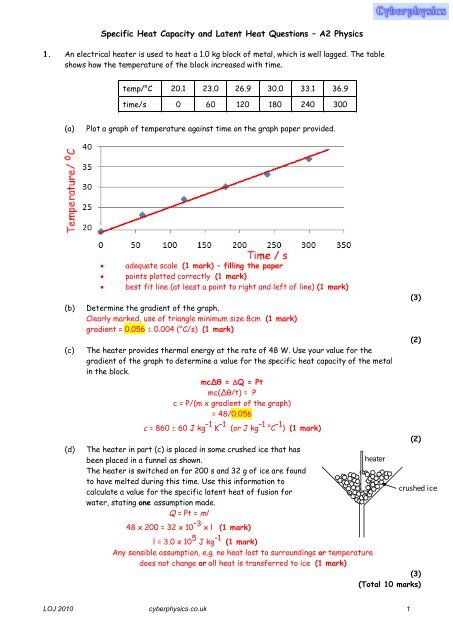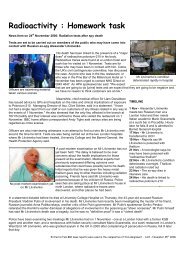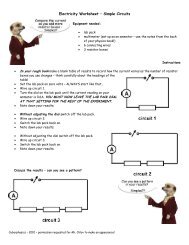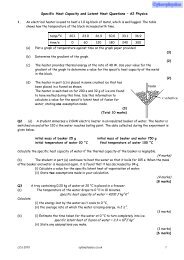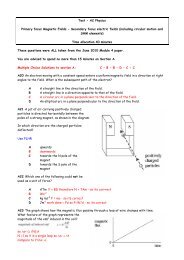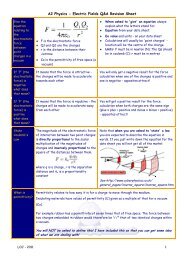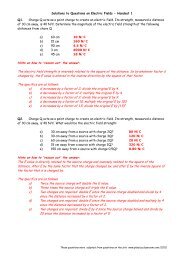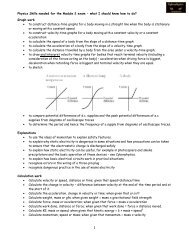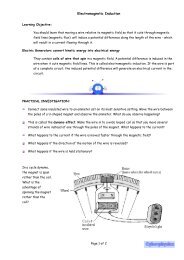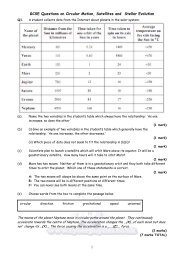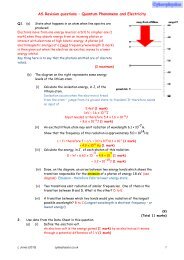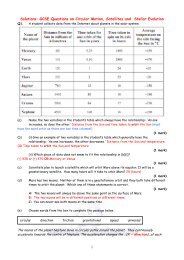Specific Heat Capacity and Latent Heat Questions ... - Cyberphysics
Specific Heat Capacity and Latent Heat Questions ... - Cyberphysics
Specific Heat Capacity and Latent Heat Questions ... - Cyberphysics
Create successful ePaper yourself
Turn your PDF publications into a flip-book with our unique Google optimized e-Paper software.
<strong>Specific</strong> <strong>Heat</strong> <strong>Capacity</strong> <strong>and</strong> <strong>Latent</strong> <strong>Heat</strong> <strong>Questions</strong> – A2 Physics<br />
1. An electrical heater is used to heat a 1.0 kg block of metal, which is well lagged. The table<br />
shows how the temperature of the block increased with time.<br />
temp/°C 20.1 23.0 26.9 30.0 33.1 36.9<br />
time/s 0 60 120 180 240 300<br />
(a)<br />
Plot a graph of temperature against time on the graph paper provided.<br />
(b)<br />
(c)<br />
(d)<br />
<br />
<br />
<br />
adequate scale (1 mark) – filling the paper<br />
points plotted correctly (1 mark)<br />
best fit line (at least a point to right <strong>and</strong> left of line) (1 mark)<br />
Determine the gradient of the graph.<br />
Clearly marked, use of triangle minimum size 8cm (1 mark)<br />
gradient = 0.056 0.004 (°C/s) (1 mark)<br />
The heater provides thermal energy at the rate of 48 W. Use your value for the<br />
gradient of the graph to determine a value for the specific heat capacity of the metal<br />
in the block.<br />
mcΔθ = Q = Pt<br />
mc(Δθ/t) = P<br />
c = P/(m x gradient of the graph)<br />
= 48/0.056<br />
c = 860 60 J kg –1 K –1 (or J kg –1 °C –1 ) (1 mark)<br />
The heater in part (c) is placed in some crushed ice that has<br />
been placed in a funnel as shown.<br />
The heater is switched on for 200 s <strong>and</strong> 32 g of ice are found<br />
to have melted during this time. Use this information to<br />
calculate a value for the specific latent heat of fusion for<br />
water, stating one assumption made.<br />
Q = Pt = ml<br />
48 x 200 = 32 x 10 –3 x l (1 mark)<br />
h e a t e r<br />
l = 3.0 x 10 5 J kg –1 (1 mark)<br />
Any sensible assumption, e.g. no heat lost to surroundings or temperature<br />
does not change or all heat is transferred to ice (1 mark)<br />
(3)<br />
(Total 10 marks)<br />
(3)<br />
(2)<br />
(2)<br />
c r u s h e d i c e<br />
LOJ 2010 cyberphysics.co.uk 1
<strong>Specific</strong> <strong>Heat</strong> <strong>Capacity</strong> <strong>and</strong> <strong>Latent</strong> <strong>Heat</strong> <strong>Questions</strong> – A2 Physics<br />
Q2 (a) A student immerses a 2.0kW electric heater in an insulated beaker of water. The heater is<br />
switched on <strong>and</strong> after 120 s the water reaches boiling point. The data collected during the experiment is<br />
given below.<br />
initial mass of beaker 25 g<br />
initial mass of beaker <strong>and</strong> water 750 g<br />
initial temperature of water 20 °C final temperature of water 100 °C<br />
Calculate the specific heat capacity of water if the thermal capacity of the beaker is negligible.<br />
mcΔθ = Q = Pt<br />
0.725 × c × (100 − 20) (1 mark)<br />
= 2000 ×120 (1 mark)<br />
c = 4100 (1 mark) J kg −1 (1 mark)<br />
(4 marks)<br />
(b) The student in part (a) continues to heat the water so that it boils for 105 s. When the mass<br />
ofthe beaker <strong>and</strong> water is measured again, it is found that it has decreased by 94 g.<br />
(i) Calculate a value for the specific latent heat of vaporisation of water.<br />
Q = ml = Pt<br />
94 × 10 −3 x l = 2000 × 105 (1 mark)<br />
l = 2.2 × 10 6 J kg −1 (1 mark)<br />
(ii) State two assumptions made in your calculation.<br />
no evaporation (before water heated to boiling point) (1 mark)<br />
no heat lost (to the surroundings) (1 mark)<br />
heater 100% efficient (1 mark) - any two<br />
Q3 A tray containing 0.20 kg of water at 20 °C is placed in a freezer.<br />
(a) The temperature of the water drops to 0 °C in 10 minutes.<br />
specific heat capacity of water = 4200 J kg -1 K –1<br />
Calculate<br />
(i) the energy lost by the water as it cools to 0 °C,<br />
ΔQ = mcΔθ<br />
energy lost by water = 0.20 × 4200 × 20 (1 mark)<br />
(b)<br />
= 1.7 × 10 4 J (1 mark) [1.68 x 10 4 J]<br />
(ii) the average rate at which the water is losing energy, in J s –1 .<br />
rate of loss of energy = (1.68 x 10 4 )/(10 x 60) = 28W (1 mark)<br />
(i) Estimate the time taken for the water at 0 °C to turn completely into ice.<br />
specific latent heat of fusion of water = 3.3 x 10 5 J kg –1<br />
ΔQ = ml = Pt<br />
(28 × t) = 0.20 × 3.3 × 10 5 (1 mark)<br />
(4 marks)<br />
[8 marks]<br />
(3 marks)<br />
t = 2.4 × 10 3 s (1 mark) (2.36 × 10 3 s)<br />
(ii) State any assumptions you make.<br />
constant rate of heat loss (1 mark)<br />
ice remains at 0oC (1 mark)<br />
(3 marks)<br />
[6 marks]<br />
Q4 (a) A 2.0kW heater is used to heat a room from 5 °C to 20 °C. The mass of air in the room is<br />
30 kg. Under these conditions the specific heat capacity of air = 1000 J kg -1 K -1 .<br />
LOJ 2010 cyberphysics.co.uk 2
<strong>Specific</strong> <strong>Heat</strong> <strong>Capacity</strong> <strong>and</strong> <strong>Latent</strong> <strong>Heat</strong> <strong>Questions</strong> – A2 Physics<br />
Calculate<br />
(i) the gain in thermal energy of the air,<br />
ΔQ = mcΔθ<br />
Q = 30 × 1000 × 15<br />
= 4.5 × 10 5 J(1 mark)<br />
(ii) the minimum time required to heat the room.<br />
P × t = 4.5 x 10 5 (1 mark)<br />
t = 45 x 10 5 /2000 = 225 s (1 mark)<br />
(4 marks)<br />
(b) State <strong>and</strong> explain one reason why the actual time taken to heat the room is longer than the value<br />
calculated in part (a)(ii).<br />
<strong>Heat</strong> is lost to surroundings or other objects in room or to heater itself(1 mark) therefore more<br />
(thermal) energy is required from heater (1 mark)<br />
[or because convection currents cause uneven heating or rate of heat transfer decreases as temperature<br />
increases]<br />
(2 marks)<br />
[6 marks]<br />
Q5. A bicycle <strong>and</strong> its rider have a total mass of 95 kg. The bicycle is travelling along a horizontal<br />
road at a constant speed of 8.0ms -1 .<br />
(a) Calculate the kinetic energy of the bicycle <strong>and</strong> rider.<br />
Ek = ½mv 2<br />
Ek = ½ x 95 x 8.0 2 (1 mark)<br />
= 3040 J (1 mark)<br />
(2 marks)<br />
(b) The brakes are applied until the bicycle <strong>and</strong> rider come to rest. During braking, 60% of<br />
the kinetic energy of the bicycle <strong>and</strong> rider is converted to thermal energy in the brake<br />
blocks. The brake blocks have a total mass of 0.12 kg <strong>and</strong> the material from which they are<br />
made has a specific heat capacity of 1200 J kg -1 K -1 .<br />
(i) Calculate the maximum rise in temperature of the brake blocks.<br />
60% of the KE = 0.60 x 3040 = 1824 (J) (1 mark)<br />
Q = mc<br />
1824 = 0.12 x 1200 x (1 mark) = 13 K (1 mark) (12.7 K)<br />
(ii) State an assumption you have made in part (b)(i).<br />
No heat is lost to the surroundings (1 mark)<br />
(4 marks)<br />
[6 marks]<br />
Q6. A female runner of mass 60 kg generates thermal energy at a rate of 800W.<br />
(a) Assuming that she loses no energy to the surroundings <strong>and</strong> that the average<br />
specific heat capacity of her body is 3900 J kg -1 K -1 , calculate<br />
(i) the thermal energy generated in one minute,<br />
Energy in one minute = 800 × 60 = 48 × 10 3 J(1 mark)<br />
(ii) the temperature rise of her body in one minute.<br />
ΔQ = mcΔθ<br />
48 × 10 3 = 60 × 3900 × Δθ (1 mark)<br />
Δθ = 0.21 K (1 mark) (0.205 K)<br />
(3 marks)<br />
LOJ 2010 cyberphysics.co.uk 3
<strong>Specific</strong> <strong>Heat</strong> <strong>Capacity</strong> <strong>and</strong> <strong>Latent</strong> <strong>Heat</strong> <strong>Questions</strong> – A2 Physics<br />
(b) In practice it is desirable for a runner to maintain a constant temperature. This may be<br />
achieved partly by the evaporation of sweat. The runner in part (a) loses energy at a rate of 500W by<br />
this process. Calculate the mass of sweat evaporated in one minute.<br />
specific latent heat of vaporisation of water = 2.3 x 10 6 J kg -1<br />
ΔQ = ml<br />
Energy in one minute: 500 × 60 (1 mark)<br />
= m × 2.3 × 10 6 (1 mark)<br />
So m = 0.013 kg (1 mark)<br />
(c) Explain why, when she stops running, her temperature is<br />
likely to fall.<br />
She is not generating as much heat internally (1 mark) but is<br />
still losing heat (at the same rate) [or still sweating] (1 mark)<br />
hence her temperature will drop (1 mark)<br />
(2 marks)<br />
[8 marks]<br />
Q7. The diagram on the right shows a tube containing<br />
small particles of lead. When the tube is inverted the particles<br />
of lead fall freely through a vertical height equal to the length<br />
of the tube.<br />
(a) Describe the energy changes that take place in the<br />
lead particles during one inversion of the tube.<br />
Lead particles fall <strong>and</strong> lose potential energy (as tube is<br />
inverted) (1 mark). This is converted to kinetic energy (1<br />
mark).Kinetic energy is converted into heat energy on impact<br />
(1 mark)<br />
(3 marks)<br />
(b) The tube is made from an insulating material <strong>and</strong> is<br />
used in an experiment to determine the specific heat capacity<br />
of lead.<br />
The following results are obtained.<br />
mass of lead:<br />
0.025 kg<br />
number of inversions: 50<br />
length of tube: 1.2m<br />
change in temperature of the lead: 4.5K<br />
(3 marks)<br />
Calculate<br />
(i)<br />
(ii)<br />
(iii)<br />
the change in potential energy of the lead as it falls after one inversion down<br />
the tube,<br />
Ep = mgh = 0.025 × 9.81 × 1.2 = 0.29(4) J (1 mark)<br />
the total change in potential energy after 50 inversions,<br />
total change of energy (= 50 × 0.294) = 15 J (1 mark) (14.7 J)<br />
(use of 0.29 gives 14.(5) J)<br />
the specific heat capacity of the lead.<br />
ΔQ = mcΔθ<br />
14.7 = 0.025 × c × 4.5 (1 mark)<br />
c = 131 J kg −1 K −1 (1 mark) (130.7 J kg −1 K −1 )<br />
(use of 15 from (ii) gives 133 J kg −1 K −1 )<br />
(4 marks)<br />
[7 marks]<br />
LOJ 2010 cyberphysics.co.uk 4
<strong>Specific</strong> <strong>Heat</strong> <strong>Capacity</strong> <strong>and</strong> <strong>Latent</strong> <strong>Heat</strong> <strong>Questions</strong> – A2 Physics<br />
Q8. In an experiment to measure the temperature of the flame of a Bunsen burner, a lump of<br />
copper of mass 0.12 kg is heated in the flame for several minutes. The copper is then transferred quickly<br />
to a beaker, of negligible heat capacity, containing 0.45 kg of water, <strong>and</strong> the temperature rise of the<br />
water measured.<br />
specific heat capacity of water = 4200 J kg -1 K -1<br />
specific heat capacity of copper = 390 J kg -1 K -1<br />
(a) If the temperature of the water rises from 15 °C to 35 °C, calculate the thermal energy<br />
gained by the water.<br />
ΔQ = mcΔ (1 mark)<br />
ΔQ = 0.45 × 4200 × (35 − 15)<br />
= 3.8 × 10 4 J (1 mark) (3.78 × 10 4 J )<br />
(2 marks)<br />
(b) (i) State the thermal energy lost by the copper, assuming no heat is lost during its<br />
transfer.<br />
3.8 × 10 4 J (1 mark)<br />
(ii) Calculate the fall in temperature of the copper.<br />
mcΔT = ΔQ<br />
0.12 × 390 × ΔT = 3.8 × 10 4 (1 mark)<br />
ΔT = 812 K (1 mark)<br />
use of ΔQ =3.78 x 10 4 J gives ΔT = 808 K<br />
(iii) Hence calculate the temperature reached by the copper while in the flame.<br />
(812 + 35) = 847 ºC (1 mark)<br />
(use of 808 gives 843 ºC)<br />
(4 marks)<br />
(6 marks)<br />
Q9.<br />
(a) Calculate the energy released when 1.5 kg of water at 18 °C cools to 0 °C <strong>and</strong> then freezes to<br />
form ice, also at 0 °C.<br />
specific heat capacity of water = 4200 J kg -1 K -1<br />
specific latent heat of fusion of ice = 3.4 × 10 5 J kg -1<br />
Water cooling to zero<br />
ΔQ = mcT<br />
ΔQ 1 = 1.5 × 4200 × 18 (1 mark)<br />
= 1.1 × 10 5 (J) (1 mark)<br />
Ice forming<br />
Δ Q 2 = 1.5 × 3.4 × 10 5<br />
= 5.1 × 10 5 (J) (1 mark)<br />
total energy released (= 1.1 ×10 5 + 5.1 × 10 5 )<br />
= 6.2 × 10 5 J(1 mark)<br />
(4 marks)<br />
(b) Explain why it is more effective to cool cans of drinks by placing them in a bucket full<br />
of melting ice rather than in a bucket of water at an initial temperature of 0 °C.<br />
Ice requires an input of latent heat energy to melt (1 mark). It therefore takes this energy from the<br />
drink before the drink begins to take energy from the melted ice. It therefore stays at 0 ºC for longer<br />
that it would in the cold water (1 mark)<br />
(2 marks)<br />
(6 marks)<br />
(63 marks Total)<br />
LOJ 2010 cyberphysics.co.uk 5


